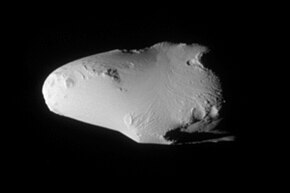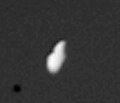Moon Calypso
Calypso is a moon of Saturn.
It was discovered in 1980, from ground-based observations, by Dan Pascu, P. Kenneth Seidelmann, William A. Baum, and Douglas G. Currie, and was provisionally designated S/1980 S 25 (the 25th satellite of Saturn discovered in 1980). Several other apparitions of it were recorded in the following months: S/1980 S 29, S/1980 S 30, S/1980 S 32, and S/1981 S 2. In 1983 it was officially named after Calypso of Greek mythology. It is also designated Saturn XIV or Tethys C.
 Calypso image from Cassini (February 13, 2010) | |
| Discovery | |
|---|---|
| Discovered by |
|
| Discovery date | March 13, 1980 |
| Designations | |
Designation | Saturn XIV |
| Pronunciation | /kəˈlɪpsoʊ/ |
Named after | Καλυψώ Kalypsō |
| Tethys C S/1980 S 25 | |
| Adjectives | Calypsoan /kælɪpˈsoʊ.ən/, Calypsonian /kælɪpˈsoʊniən/ |
| Orbital characteristics | |
| 295000 km | |
| Eccentricity | 0.001 |
| 1.887803 d | |
| Inclination | 1.56° (to Saturn's equator) |
| Satellite of | Saturn |
| Group | L5 Tethys trojan |
| Physical characteristics | |
| Dimensions | 29.4 × 18.6 × 12.8 km (± 0.6 × 1.8 × 0.6 km): 2 |
Mean diameter | 19.0±0.8 km: 2 |
| Volume | 3591 km3 |
| Mass | ≈ 2×1015 kg (assumed; unmeasured) |
Mean density | ≈ 0.5 g/cm3 (assumed; unmeasured): 3 |
| ≈ 0.0009–0.0013 m/s2: 3 | |
| ≈ 0.004 km/s at longest axis to ≈ 0.006 km/s at poles | |
| synchronous | |
| zero | |
| Albedo | 1.34±0.10 (geometric) |
Calypso is co-orbital with the moon Tethys, and resides in Tethys' trailing Lagrangian point (L5), 60 degrees behind Tethys. This relationship was first identified by Seidelmann et al. in 1981. The moon Telesto resides in the other (leading) Lagrangian point of Tethys, 60 degrees in the other direction from Tethys. Calypso and Telesto have been termed "Tethys trojans", by analogy to the trojan asteroids, and are half of the four presently known trojan moons.
Like many other small Saturnian moons and small asteroids, Calypso is irregularly shaped, has overlapping large craters, and appears to also have loose surface material capable of smoothing the craters' appearance. Its surface is one of the most reflective (at visual wavelengths) in the Solar System, with a visual geometric albedo of 1.34. This very high albedo is the result of the sandblasting of particles from Saturn's E-ring, a faint ring composed of small, water-ice particles generated by Enceladus' south polar geysers.
Gallery
See also
Notes
References
Citations

This article uses material from the Wikipedia English article Calypso (moon), which is released under the Creative Commons Attribution-ShareAlike 3.0 license ("CC BY-SA 3.0"); additional terms may apply (view authors). Content is available under CC BY-SA 4.0 unless otherwise noted. Images, videos and audio are available under their respective licenses.
®Wikipedia is a registered trademark of the Wiki Foundation, Inc. Wiki English (DUHOCTRUNGQUOC.VN) is an independent company and has no affiliation with Wiki Foundation.


